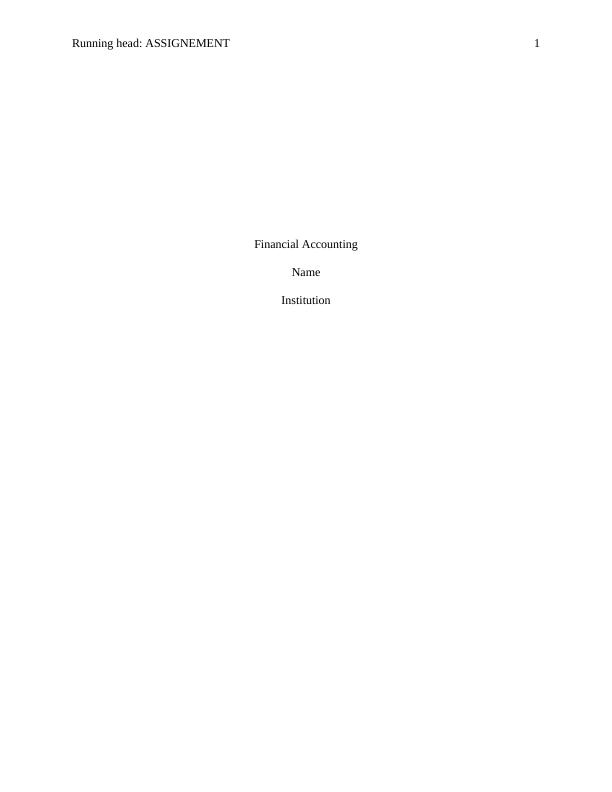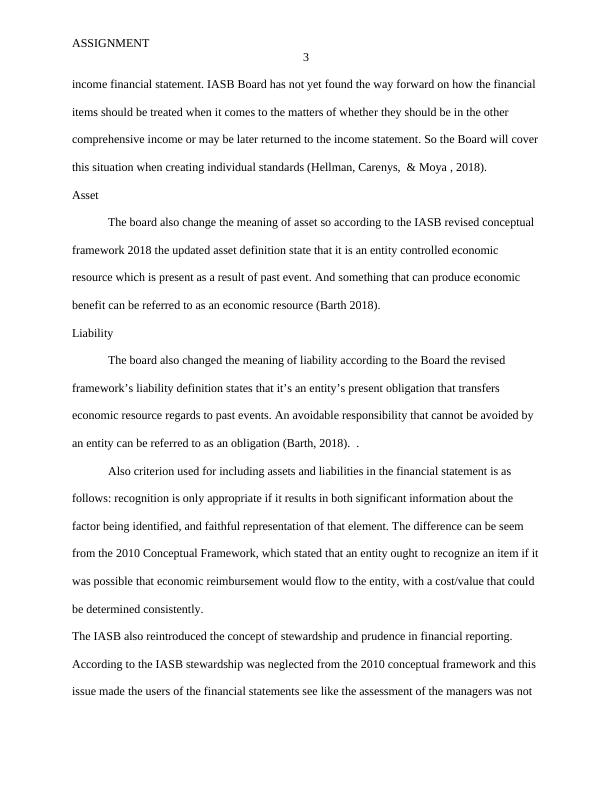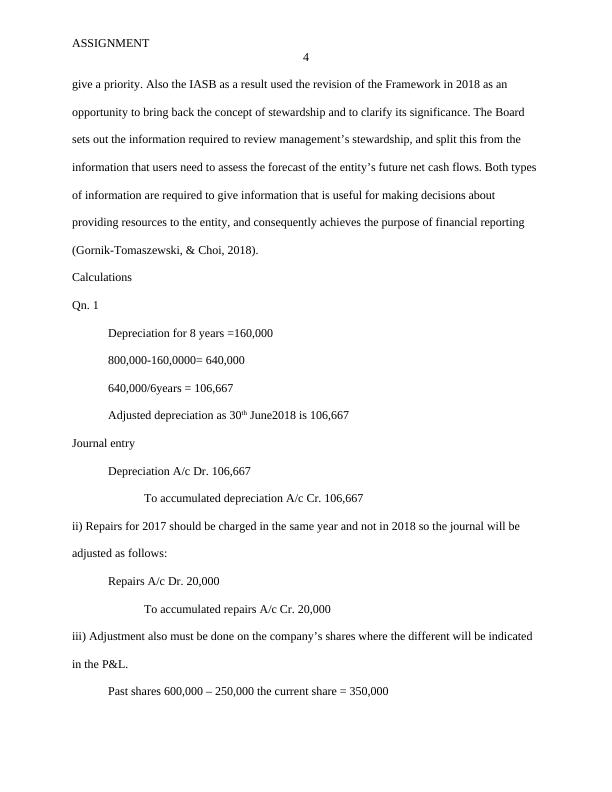Changes and Development on Accounting Standards
Added on 2023-06-07
17 Pages2898 Words275 Views
Running head: ASSIGNEMENT 1
Financial Accounting
Name
Institution
Financial Accounting
Name
Institution

ASSIGNMENT
2
Identification of changes and development on accounting standards.
The International Accounting standards Board (IASB) has made changes on the
accounting standards. The Board revised the following areas of the accounting standards and
these are as follows:
Measurement, presentation and disclosure.
Definitions of an asset and liability and recognition criteria.
The reintroduction of stewardship and prudence in financial reporting.
Measurement basis.
Starting with the changes made on measurement the IASB made it clear way on how to choose a
measurement basis and this is as follows:
There are two measurement basis these are current value and historical cost
measurement basis. According to the IASB improvement was made on when choosing a
measurement basis, the entity needs also to think about the nature of the information whether it
will be presented in the financial statements. Cost will also limit the selection of a measurement
basis. So the board acknowledges that contemplation of all these factors are possible to respond
in the choice of distinct measurement basis for different expenses, liabilities, income and assets
Martin, & Osma, 2018).
Presentation and Disclosure
The other changes were in the area of presentation and disclosure and these where the
change made by the Board concerning this area. The Board revised the conceptual framework
because of the introduction of concepts unfolding how information should be presented and
disclosed in financial statements. Also to be provided with the direction on classifying expenses
and income, in addition to this the information will determine whether to be integrated in the
2
Identification of changes and development on accounting standards.
The International Accounting standards Board (IASB) has made changes on the
accounting standards. The Board revised the following areas of the accounting standards and
these are as follows:
Measurement, presentation and disclosure.
Definitions of an asset and liability and recognition criteria.
The reintroduction of stewardship and prudence in financial reporting.
Measurement basis.
Starting with the changes made on measurement the IASB made it clear way on how to choose a
measurement basis and this is as follows:
There are two measurement basis these are current value and historical cost
measurement basis. According to the IASB improvement was made on when choosing a
measurement basis, the entity needs also to think about the nature of the information whether it
will be presented in the financial statements. Cost will also limit the selection of a measurement
basis. So the board acknowledges that contemplation of all these factors are possible to respond
in the choice of distinct measurement basis for different expenses, liabilities, income and assets
Martin, & Osma, 2018).
Presentation and Disclosure
The other changes were in the area of presentation and disclosure and these where the
change made by the Board concerning this area. The Board revised the conceptual framework
because of the introduction of concepts unfolding how information should be presented and
disclosed in financial statements. Also to be provided with the direction on classifying expenses
and income, in addition to this the information will determine whether to be integrated in the

ASSIGNMENT
3
income financial statement. IASB Board has not yet found the way forward on how the financial
items should be treated when it comes to the matters of whether they should be in the other
comprehensive income or may be later returned to the income statement. So the Board will cover
this situation when creating individual standards (Hellman, Carenys, & Moya , 2018).
Asset
The board also change the meaning of asset so according to the IASB revised conceptual
framework 2018 the updated asset definition state that it is an entity controlled economic
resource which is present as a result of past event. And something that can produce economic
benefit can be referred to as an economic resource (Barth 2018).
Liability
The board also changed the meaning of liability according to the Board the revised
framework’s liability definition states that it’s an entity’s present obligation that transfers
economic resource regards to past events. An avoidable responsibility that cannot be avoided by
an entity can be referred to as an obligation (Barth, 2018). .
Also criterion used for including assets and liabilities in the financial statement is as
follows: recognition is only appropriate if it results in both significant information about the
factor being identified, and faithful representation of that element. The difference can be seem
from the 2010 Conceptual Framework, which stated that an entity ought to recognize an item if it
was possible that economic reimbursement would flow to the entity, with a cost/value that could
be determined consistently.
The IASB also reintroduced the concept of stewardship and prudence in financial reporting.
According to the IASB stewardship was neglected from the 2010 conceptual framework and this
issue made the users of the financial statements see like the assessment of the managers was not
3
income financial statement. IASB Board has not yet found the way forward on how the financial
items should be treated when it comes to the matters of whether they should be in the other
comprehensive income or may be later returned to the income statement. So the Board will cover
this situation when creating individual standards (Hellman, Carenys, & Moya , 2018).
Asset
The board also change the meaning of asset so according to the IASB revised conceptual
framework 2018 the updated asset definition state that it is an entity controlled economic
resource which is present as a result of past event. And something that can produce economic
benefit can be referred to as an economic resource (Barth 2018).
Liability
The board also changed the meaning of liability according to the Board the revised
framework’s liability definition states that it’s an entity’s present obligation that transfers
economic resource regards to past events. An avoidable responsibility that cannot be avoided by
an entity can be referred to as an obligation (Barth, 2018). .
Also criterion used for including assets and liabilities in the financial statement is as
follows: recognition is only appropriate if it results in both significant information about the
factor being identified, and faithful representation of that element. The difference can be seem
from the 2010 Conceptual Framework, which stated that an entity ought to recognize an item if it
was possible that economic reimbursement would flow to the entity, with a cost/value that could
be determined consistently.
The IASB also reintroduced the concept of stewardship and prudence in financial reporting.
According to the IASB stewardship was neglected from the 2010 conceptual framework and this
issue made the users of the financial statements see like the assessment of the managers was not

ASSIGNMENT
4
give a priority. Also the IASB as a result used the revision of the Framework in 2018 as an
opportunity to bring back the concept of stewardship and to clarify its significance. The Board
sets out the information required to review management’s stewardship, and split this from the
information that users need to assess the forecast of the entity’s future net cash flows. Both types
of information are required to give information that is useful for making decisions about
providing resources to the entity, and consequently achieves the purpose of financial reporting
(Gornik-Tomaszewski, & Choi, 2018).
Calculations
Qn. 1
Depreciation for 8 years =160,000
800,000-160,0000= 640,000
640,000/6years = 106,667
Adjusted depreciation as 30th June2018 is 106,667
Journal entry
Depreciation A/c Dr. 106,667
To accumulated depreciation A/c Cr. 106,667
ii) Repairs for 2017 should be charged in the same year and not in 2018 so the journal will be
adjusted as follows:
Repairs A/c Dr. 20,000
To accumulated repairs A/c Cr. 20,000
iii) Adjustment also must be done on the company’s shares where the different will be indicated
in the P&L.
Past shares 600,000 – 250,000 the current share = 350,000
4
give a priority. Also the IASB as a result used the revision of the Framework in 2018 as an
opportunity to bring back the concept of stewardship and to clarify its significance. The Board
sets out the information required to review management’s stewardship, and split this from the
information that users need to assess the forecast of the entity’s future net cash flows. Both types
of information are required to give information that is useful for making decisions about
providing resources to the entity, and consequently achieves the purpose of financial reporting
(Gornik-Tomaszewski, & Choi, 2018).
Calculations
Qn. 1
Depreciation for 8 years =160,000
800,000-160,0000= 640,000
640,000/6years = 106,667
Adjusted depreciation as 30th June2018 is 106,667
Journal entry
Depreciation A/c Dr. 106,667
To accumulated depreciation A/c Cr. 106,667
ii) Repairs for 2017 should be charged in the same year and not in 2018 so the journal will be
adjusted as follows:
Repairs A/c Dr. 20,000
To accumulated repairs A/c Cr. 20,000
iii) Adjustment also must be done on the company’s shares where the different will be indicated
in the P&L.
Past shares 600,000 – 250,000 the current share = 350,000

End of preview
Want to access all the pages? Upload your documents or become a member.
Related Documents
Why IASB Revised the Conceptual Framework and Key Improvements Madelg...
|9
|2348
|77
Developing Suitable Accounting Policies for Financial Reportinglg...
|11
|3575
|345
The Conceptual Framework – Changes, Implications and Perceived Benefitslg...
|19
|4804
|63
Theory and Current Issues in Accounting - AASB Frameworklg...
|17
|3251
|127
IASB Conceptual Framework: Definition and Recognition of Liabilitieslg...
|11
|591
|260
Chapter 2 – Literature Review and Conceptual Frameworklg...
|13
|4142
|156